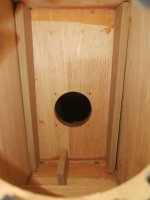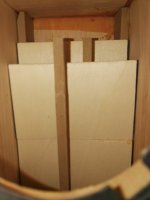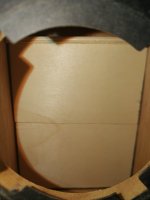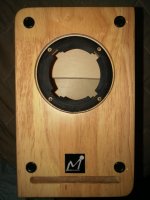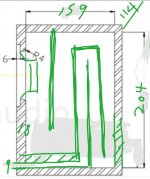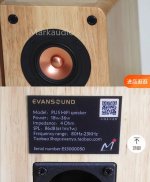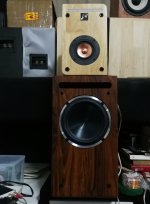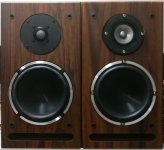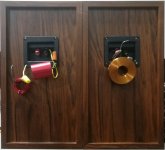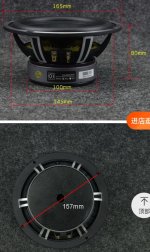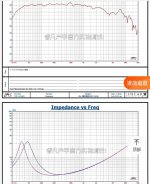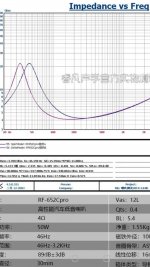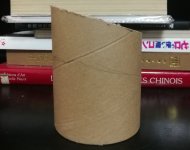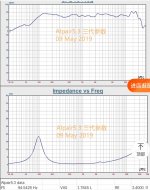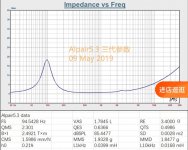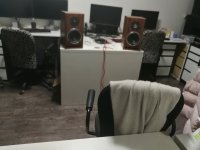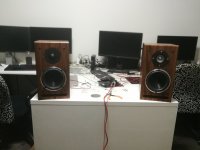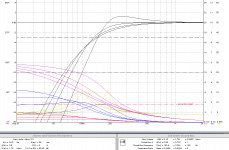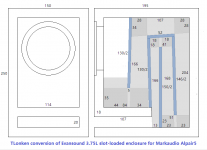This is a fork from the thread in multi-way:
https://www.diyaudio.com/community/...ter-than-tweeters.393474/page-15#post-7215679
I usually start from a ready-made, attractive slot-loaded compact cabinet, then using simple tools and material, extend the slot into a tapered transmission line "labyrinth". Similar to MLTL. After Dave suggested Alpair 5.3 for mid-tweeter duty, I got interested and (really) lucked into a used pair of well-built mini speakers as described in the thread title. Over several days I intend to compare: the fullrange A5.2 TLonken; A5.2 as midrange-tweeter crossed over to (sub) woofer; and a "classic" 2-way (such as formidable Joseph Audio RM7XL).
Pictures below show the TLonken's construction -- remodeling-in-place -- using plywood dividers each small enough to fit through the driver hole then flipped/rotated into position, held by tension and bracing. Reversible and adjustable -- no glue-down at this point. The "line" will be 0.8-1.2m long depending on how many vertical dividers are added behind the driver, incrementally -- part of the test and a big part of the fun!
https://www.diyaudio.com/community/...ter-than-tweeters.393474/page-15#post-7215679
I usually start from a ready-made, attractive slot-loaded compact cabinet, then using simple tools and material, extend the slot into a tapered transmission line "labyrinth". Similar to MLTL. After Dave suggested Alpair 5.3 for mid-tweeter duty, I got interested and (really) lucked into a used pair of well-built mini speakers as described in the thread title. Over several days I intend to compare: the fullrange A5.2 TLonken; A5.2 as midrange-tweeter crossed over to (sub) woofer; and a "classic" 2-way (such as formidable Joseph Audio RM7XL).
Pictures below show the TLonken's construction -- remodeling-in-place -- using plywood dividers each small enough to fit through the driver hole then flipped/rotated into position, held by tension and bracing. Reversible and adjustable -- no glue-down at this point. The "line" will be 0.8-1.2m long depending on how many vertical dividers are added behind the driver, incrementally -- part of the test and a big part of the fun!
Attachments
First Sound.
To begin testing its bass potential, the shortest TL with only half a board directly behind the driver was used (as pictured above), and no stuffing/wall treatment at all. The "official" cab itself was well-made from 18mm fingered oak, but as Dave pointed out rather too large for the driver (Vas~1.8L); BR-related issues (before TL) immediately apparent: bass lacked clarity, impact, and depth.
The TLonken bass performed better than I expected -- useful down to 50hz, really good from 75hz and no obvious unevenness above 100hz. Directly compared against Joseph RM7XL (BR) playing Dvorak bass drum symphony #9, the TLonken bass was drier with greater clarity and impact, more lively if perhaps a bit less refined. Only on the organ's very lowest forte note in Engleskyts was "authority" felt a little lacking. (Further extending the line and adding stuffing to slow sound may solve that.)
The bass tests were done at a sound level slightly above what I normally would set, assuming neighbors were away, in a 5x5 meter room (my retreat); speakers at least 1.5m from any wall and ~3.5m from listening position. The TLonken and Joseph 2-way were about equal in bass sensitivity; TLonken more impactful, Joseph somewhat deeper and likely louder when really pushed. Where the TLonken suffered in comparison, was the much smaller baffle's uncompensated rising response above 2khz. While this was obvious head-to-head or using a tone-sweep, listening to music it may be acceptable or even "more lively".
Happy New Year from Beijing!
To begin testing its bass potential, the shortest TL with only half a board directly behind the driver was used (as pictured above), and no stuffing/wall treatment at all. The "official" cab itself was well-made from 18mm fingered oak, but as Dave pointed out rather too large for the driver (Vas~1.8L); BR-related issues (before TL) immediately apparent: bass lacked clarity, impact, and depth.
The TLonken bass performed better than I expected -- useful down to 50hz, really good from 75hz and no obvious unevenness above 100hz. Directly compared against Joseph RM7XL (BR) playing Dvorak bass drum symphony #9, the TLonken bass was drier with greater clarity and impact, more lively if perhaps a bit less refined. Only on the organ's very lowest forte note in Engleskyts was "authority" felt a little lacking. (Further extending the line and adding stuffing to slow sound may solve that.)
The bass tests were done at a sound level slightly above what I normally would set, assuming neighbors were away, in a 5x5 meter room (my retreat); speakers at least 1.5m from any wall and ~3.5m from listening position. The TLonken and Joseph 2-way were about equal in bass sensitivity; TLonken more impactful, Joseph somewhat deeper and likely louder when really pushed. Where the TLonken suffered in comparison, was the much smaller baffle's uncompensated rising response above 2khz. While this was obvious head-to-head or using a tone-sweep, listening to music it may be acceptable or even "more lively".
Happy New Year from Beijing!
Last edited:
Brief update. The A5.2 TLonken bass actually went as deep as the Joseph (both ~50hz), probably Fb~56hz and pretty good above 65hz; Joseph BR a bit more 60-65hz, a bit less 55-60hz. TLonken bass was clearer and more impactful than the more relaxed BR.
Then I ignored the Joseph and tried to make a 2-way, A5.2 sealed up (still ~3.5L) with AIRS 6.5" Al2O3/Alumina (sub) woofer in a separate ~14L "Z or 7" labyrinth (purchased cheap ready-made, then seriously anti-vibration enhanced). I tried various (first-order) passive XO but in the end returned to FAST -- Fullrange Augmented Straight-Through -- because the tiny A5.2 played louder and better without HPF in the way (100-166uF Jantzen CrossCap + StandardZCaps). The woofer LPF ended up 9mH Jantzen aircore (1.8ohm which cancelled its excess sensitivity) first-order @~125hz matching the sealed A5.2 natural fall-off beginning ~140hz. I think this is a pretty traditional setup and sounded pretty good, certainly deeper and more controlled sound than the initial short TLonken. I ran out of time to compare them directly or to attempt optimization (such as lengthening TL, second-order LPF).
(For the tests a pair of TPA3221 micro amps were used.)
Then I ignored the Joseph and tried to make a 2-way, A5.2 sealed up (still ~3.5L) with AIRS 6.5" Al2O3/Alumina (sub) woofer in a separate ~14L "Z or 7" labyrinth (purchased cheap ready-made, then seriously anti-vibration enhanced). I tried various (first-order) passive XO but in the end returned to FAST -- Fullrange Augmented Straight-Through -- because the tiny A5.2 played louder and better without HPF in the way (100-166uF Jantzen CrossCap + StandardZCaps). The woofer LPF ended up 9mH Jantzen aircore (1.8ohm which cancelled its excess sensitivity) first-order @~125hz matching the sealed A5.2 natural fall-off beginning ~140hz. I think this is a pretty traditional setup and sounded pretty good, certainly deeper and more controlled sound than the initial short TLonken. I ran out of time to compare them directly or to attempt optimization (such as lengthening TL, second-order LPF).
(For the tests a pair of TPA3221 micro amps were used.)
Attachments
Last edited:
Next comp will be between brand-new dark-silver Alpair 5.3 and local brand Lxcopy/Molisio ceramic dome, each teamed with AIRS Alumina deep-bass mid-woofer. Sealed A5.3 FAST, air-core 9mH 1st-order LPF on the woofer; 1st-order-series XO ~2khz on the ceramics. Ran out of time though, and can't crank up the A5.3 anyway for a couple hundred hours....
Attachments
Thanks for the question. Even though the new A5.3 has only had a few hours and I'm testing at 3am i.e. very low SPL, after trying many combinations I haven't heard any obvious impedance effect -- the hump 120-125 and dip 180 had been there anyway, woofer-cabinet interaction, with 9mH (air-core 1.85ohm) inline or without (then louder of course). Reversing polarity on one driver has some audible effect. Anyway, the two drivers are for now electrically unconnected channels. A5.3 straight-through and sealed in a piece of cardboard tube maybe half-liter, fall-off starting below 140. Woofer published specs attached (FWIW). Cab is "7-shaped" labyrinth meaning a very exaggerated taper/choke possibly closer to double-reflex, I don't know; seriously anti-vibration enhanced.When you say a 9mH inductor on the midbass -how significantly is that interacting with the upper box impedance peak? Without data it's impossible to know for certain, but I'd expect it to put anything up to about a 3dB peak in the mid-upper bass region without compensation.
I'm not even sure whether to add the inductor's 1.85ohm resistance to the woofer's 4ohm impedance for calculating LPF.... So any help or critique will be appreciated.
Attachments
Listening again in the morning at closer to normal volume, the woofer-in-7-shaped-labyrinth has a middling double hump higher at 123, lower (easily missed) at 144. The Alpair fall-off starts below 140 but pretty shallow until ~110.
I made the other speaker some time ago, using the same Alumina woofer but 1st-order-series XO to a ceramic dome tweeter. Soundwise, clean/cold/hard/detailed like ceramic ought to be, I guess. So a "stacked" old Mission PP mid-woofer was run straight-through in parallel to add some warmth and bounce (named "Lumin77"). This comp against A5.3 will be just the ceramic 2-way.
The cardboard tube enclosure for the A5.3 should be reinforced/coated (with what?). The slant cut was first traced with a pencil pressed against the baffle, the tube pressed against the "7" cab internal divider.
I made the other speaker some time ago, using the same Alumina woofer but 1st-order-series XO to a ceramic dome tweeter. Soundwise, clean/cold/hard/detailed like ceramic ought to be, I guess. So a "stacked" old Mission PP mid-woofer was run straight-through in parallel to add some warmth and bounce (named "Lumin77"). This comp against A5.3 will be just the ceramic 2-way.
The cardboard tube enclosure for the A5.3 should be reinforced/coated (with what?). The slant cut was first traced with a pencil pressed against the baffle, the tube pressed against the "7" cab internal divider.
Attachments
Last edited:
Update.
I listened to the FAST A5.3/Alumina louder than before (still not really loud) -- bi-amped; or parallel-connected; or woofer only. Basically the same story: a wide shelf 110-150 with low peaks 123 and 144 and a bit of jaggedness up to 200. I think the cardboard tube A5.3 enclosure is contributing vibration and resonance, worse with the driver playing. I expected parallel-connected to be a tad different than bi-amped -- the inductor (itself 1.85-ohm, to 4-ohm woofer) letting some current bypass the A5.3 (4-ohm nominal, 6-ohm at 200, 16-ohm at 100, before even considering the small-enclosure effect), and maybe there was a difference but I couldn't be sure. The published chart for the A5.3 showed falling slope from 100 to 200, and the 7-shaped labyrinth for the woofer plus cardboard tube vibration probably all contributed to the shelf/double-hump.
I re-made the ceramic-dome/Alumina-woofer 2-way (was 3-way with Mission PP-cone mid-woofer run straight-through, a common Mission practice, woofer LP 2khz and tweeter HP 6khz). Still 1st-order-series XO but HP also at 2khz. I then performed phase alignment test by moving tweeter back-and-forth playing 2khz tone and listening for maximum; turned out reversing polarity was just about right. 2-ohm resistor-chain equalized tweeter and woofer; another 1-ohm before the XO matched volume with A5.3.
And the match was on! Each speaker played one channel. A section of music would be played twice quickly in succession, the L/R inputs to the (TPA3221) amp instantaneously swapped. This method required the contestants to be similar enough to form stereo image together; then the left and right half-soundstage could be nearly directly compared (sight/hearing allowed to focus on one speaker or the other). If one side won both times (playing L and R channels both) then it won the contest.
A5.3/woofer sound was rounder and sweeter, and if less than 1.5m away, more holographic (effortlessly deep soundstage; even mono has depth). Ceramic-dome/woofer was flatter and smoother, with amply airy highs and louder, cleaner bass (no monster inductor LPF). 2-way driver C2C 15cm precluded close listening really; but turned holographic beginning 1.5m away from speaker (this required reversing tweeter polarity). Ceramic sound occasionally betrayed itself as brittle porcelain; and Alumina Al2O3 running to 2khz was a bit less lively than crossing below 200hz to Mg-Al alloy A5.3. Yet somehow despite its cold, pure, dry sound, I was drawn relaxing into its playing. Odd eh?
The A5.3/woofer bass region needed some work.
I listened to the FAST A5.3/Alumina louder than before (still not really loud) -- bi-amped; or parallel-connected; or woofer only. Basically the same story: a wide shelf 110-150 with low peaks 123 and 144 and a bit of jaggedness up to 200. I think the cardboard tube A5.3 enclosure is contributing vibration and resonance, worse with the driver playing. I expected parallel-connected to be a tad different than bi-amped -- the inductor (itself 1.85-ohm, to 4-ohm woofer) letting some current bypass the A5.3 (4-ohm nominal, 6-ohm at 200, 16-ohm at 100, before even considering the small-enclosure effect), and maybe there was a difference but I couldn't be sure. The published chart for the A5.3 showed falling slope from 100 to 200, and the 7-shaped labyrinth for the woofer plus cardboard tube vibration probably all contributed to the shelf/double-hump.
I re-made the ceramic-dome/Alumina-woofer 2-way (was 3-way with Mission PP-cone mid-woofer run straight-through, a common Mission practice, woofer LP 2khz and tweeter HP 6khz). Still 1st-order-series XO but HP also at 2khz. I then performed phase alignment test by moving tweeter back-and-forth playing 2khz tone and listening for maximum; turned out reversing polarity was just about right. 2-ohm resistor-chain equalized tweeter and woofer; another 1-ohm before the XO matched volume with A5.3.
And the match was on! Each speaker played one channel. A section of music would be played twice quickly in succession, the L/R inputs to the (TPA3221) amp instantaneously swapped. This method required the contestants to be similar enough to form stereo image together; then the left and right half-soundstage could be nearly directly compared (sight/hearing allowed to focus on one speaker or the other). If one side won both times (playing L and R channels both) then it won the contest.
A5.3/woofer sound was rounder and sweeter, and if less than 1.5m away, more holographic (effortlessly deep soundstage; even mono has depth). Ceramic-dome/woofer was flatter and smoother, with amply airy highs and louder, cleaner bass (no monster inductor LPF). 2-way driver C2C 15cm precluded close listening really; but turned holographic beginning 1.5m away from speaker (this required reversing tweeter polarity). Ceramic sound occasionally betrayed itself as brittle porcelain; and Alumina Al2O3 running to 2khz was a bit less lively than crossing below 200hz to Mg-Al alloy A5.3. Yet somehow despite its cold, pure, dry sound, I was drawn relaxing into its playing. Odd eh?
The A5.3/woofer bass region needed some work.
Attachments
a wide shelf 110-150 with low peaks 123 and 144 and a bit of jaggedness up to 200
Room?
dave
I'll swap their places next time. The 2-way bass is pretty smooth no issues; much more room on that side. Thanks.Small enuff that room affects will start below 300 Hz.
Last edited by a moderator:
Swapping places in the morning quick-listen/test at loud-ish volume did seem to make a difference -- the 2-way gained a shelf 80-110; the A5.3 not as ripply as before, and more-or-less in line with the published FR hump 106-123(peak)-150, made more resonant by the cardboard tube (to be dealt with). Down below, 40-80hz they weren't much different on tone-sweep, perhaps insufficient SPL used. Both played back deep organ and piano bass with clarity and gusto, other than resonances noted above.I'll swap their places next time. The 2-way bass is pretty smooth no issues; much more room on that side. Thanks.
Quite a learning experience thus far. Next round I'll relocate/angle their positions to minimize room effects and deal with resonances and ripples etc. Thanks everyone!
Yes the three-box chart (without infinite baffle I presume) posted to the other thread. I based the initial 2-box FAST on it (post #3 of this thread). Listening again tonight to the sealed-up A5.2 in 3.75L, bass response had the "pinched" 240 slightly above 400, slow fall-off through 140 down a bit to 100, only then off-a-cliff. Like the chart's 0.5L curve but boosted through ~100 per published FR chart. My new A5.3 tube-back must be leaking; no pinch, steady slow fall-off from 400 (hump starting above 480). When I get a chance I'll try to get to the bottom of it!
Ha the two-hundred-dollar question (cost less XO). Pretty near great actually, considering brand new driver. In my demented demerit-based realism-rating system the A5.3/Alumina FAST might be able to approach -3 A/A/A (hi/mid/lo) from below, much consideration given for work-in-progress. Compare: A5.2 TLonken -4 A/A/A-; 2-way ceramic-dome/Alumina "lumin7" -3 A+/A-/A or 3-way with Mission mid-woofer straight-through "lumin77" -1 A+/A/A+.
The FAST's technical challenge is the monster inductor of course. Still unsure if lo A is possible passive with it. (I hoarded Jantzen L/C single-pairs years ago during a super sale; astronomical now.)
The FAST's technical challenge is the monster inductor of course. Still unsure if lo A is possible passive with it. (I hoarded Jantzen L/C single-pairs years ago during a super sale; astronomical now.)
Last edited:
Here is the TLonken design schematic with divider boards (5mm plywood) in blue, and bracing sticks (8mm MDF) in gray. To fit through the driver hole the dividers are split into pieces no larger than 114x75. The dividers are cut slightly narrow and edged with 1mm gasket foam. The braces are calculated and cut before hand, ready to file down for a snug fit. Importantly, the process alternates positioning brace and divider so everything is inserted/flipped/rotated into position then pushed/pulled tightly, to be held by tension alone. Capping the final, front-most divider piece turns out to be a real doozie, but absolutely worth it -- the little TLonken with 1.05m-line plays organ and piano deep bass fortissimo with easy authority.

Of course, easy if built from scratch the usual way. But anyone who has a natural car-parking ability and good dexterity working blind is most welcome to try this exercise!
(Disclosure:: I studied mathematics and my father was a plastic surgeon.)
Of course, easy if built from scratch the usual way. But anyone who has a natural car-parking ability and good dexterity working blind is most welcome to try this exercise!
(Disclosure:: I studied mathematics and my father was a plastic surgeon.)
Attachments
Last edited:
- Home
- Loudspeakers
- Full Range
- TLonken to Welcome New Year! Markaudio Alpair 5.2 in Evansound 3.75L
